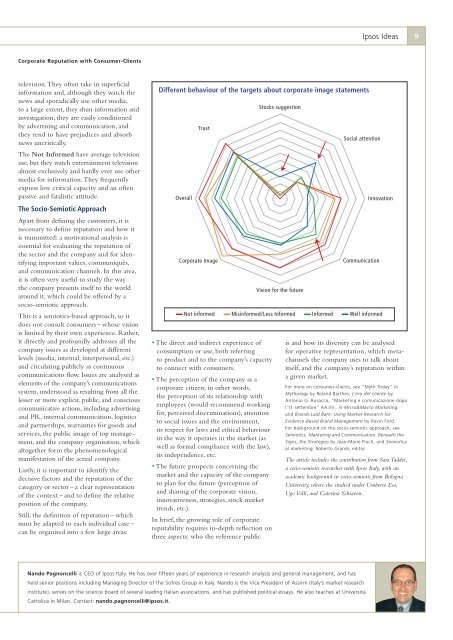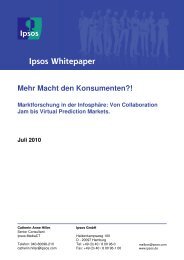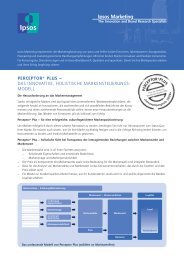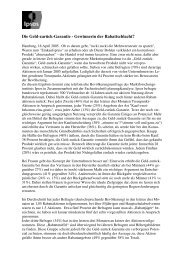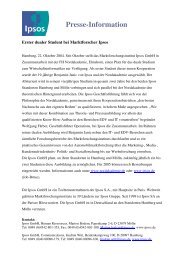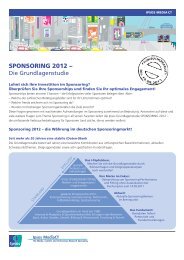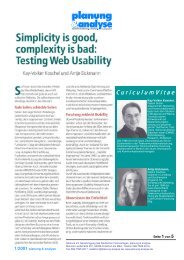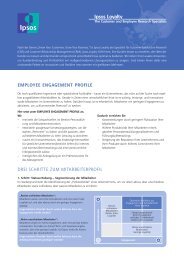Corporate Reputation:
Corporate Reputation:
Corporate Reputation:
Create successful ePaper yourself
Turn your PDF publications into a flip-book with our unique Google optimized e-Paper software.
<strong>Corporate</strong> <strong>Reputation</strong> with Consumer-Clients<br />
television.They often take in superficial<br />
information and, although they watch the<br />
news and sporadically use other media,<br />
to a large extent, they shun information and<br />
investigation, they are easily conditioned<br />
by advertising and communication, and<br />
they tend to have prejudices and absorb<br />
news uncritically.<br />
The Not Informed have average television<br />
use, but they watch entertainment television<br />
almost exclusively and hardly ever use other<br />
media for information.They frequently<br />
express low critical capacity and an often<br />
passive and fatalistic attitude.<br />
The Socio-Semiotic Approach<br />
Apart from defining the customers, it is<br />
necessary to define reputation and how it<br />
is transmitted: a motivational analysis is<br />
essential for evaluating the reputation of<br />
the sector and the company and for identifying<br />
important values, communiqués,<br />
and communication channels. In this area,<br />
it is often very useful to study the way<br />
the company presents itself to the world<br />
around it, which could be offered by a<br />
socio-semiotic approach.<br />
This is a semiotics-based approach, so it<br />
does not consult consumers – whose vision<br />
is limited by their own experience. Rather,<br />
it directly and profoundly addresses all the<br />
company issues as developed at different<br />
levels (media, internal, interpersonal, etc.)<br />
and circulating publicly as continuous<br />
communications flow. Issues are analysed as<br />
elements of the company’s communications<br />
system, understood as resulting from all the<br />
lesser or more explicit, public, and conscious<br />
communicative actions, including advertising<br />
and PR, internal communication, logistics<br />
and partnerships, warranties for goods and<br />
services, the public image of top management,<br />
and the company organisation, which<br />
altogether form the phenomenological<br />
manifestation of the actual company.<br />
Lastly, it is important to identify the<br />
decisive factors and the reputation of the<br />
category or sector – a clear representation<br />
of the context – and to define the relative<br />
position of the company.<br />
Still, the definition of reputation – which<br />
must be adapted to each individual case –<br />
can be organised into a few large areas:<br />
Different behaviour of the targets about corporate image statements<br />
• The direct and indirect experience of<br />
consumption or use, both referring<br />
to product and to the company’s capacity<br />
to connect with consumers.<br />
• The perception of the company as a<br />
corporate citizen; in other words,<br />
the perception of its relationship with<br />
employees (would recommend working<br />
for, perceived discriminations), attention<br />
to social issues and the environment,<br />
its respect for laws and ethical behaviour<br />
in the way it operates in the market (as<br />
well as formal compliance with the law),<br />
its independence, etc.<br />
• The future prospects concerning the<br />
market and the capacity of the company<br />
to plan for the future (perception of<br />
and sharing of the corporate vision,<br />
innovativeness, strategies, stock market<br />
trends, etc.).<br />
In brief, the growing role of corporate<br />
reputability requires in-depth reflection on<br />
three aspects: who the reference public<br />
Ipsos Ideas<br />
is and how its diversity can be analysed<br />
for operative representation, which metachannels<br />
the company uses to talk about<br />
itself, and the company’s reputation within<br />
a given market.<br />
For more on consumer-clients, see “Myth Today” in<br />
Mythology by Roland Barthes, L’era del cliente by<br />
Antonio G. Busacca, “Marketing e comunicazione dopo<br />
l’11 settembre” AA.VV., in Micro&Macro Marketing,<br />
and Brands Laid Bare: Using Market Research for<br />
Evidence-Based Brand Management by Kevin Ford.<br />
For background on the socio-semiotic approach, see<br />
Semiotics, Marketing and Communication: Beneath the<br />
Signs, the Strategies by Jean-Marie Floch, and Semiotica<br />
al marketing, Roberto Grandi, editor.<br />
The article includes the contribution from Sara Taddei,<br />
a socio-semiotic researcher with Ipsos Italy, with an<br />
academic background in socio-semiotic from Bologna<br />
University, where she studied under Umberto Eco,<br />
Ugo Volli, and Caterina Schiavon.<br />
Nando Pagnoncelli is CEO of Ipsos Italy. He has over fifteen years of experience in research analysis and general management, and has<br />
held senior positions including Managing Director of the Sofres Group in Italy. Nando is the Vice President of Assirm (Italy’s market research<br />
institute), serves on the science board of several leading Italian associations, and has published political essays. He also teaches at Università<br />
Cattolica in Milan. Contact: nando.pagnoncelli@ipsos.it.<br />
9


